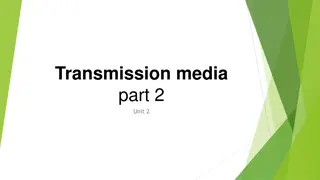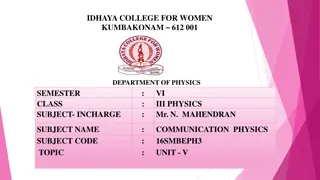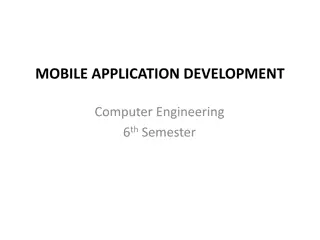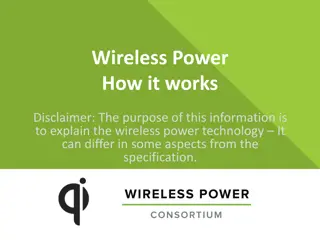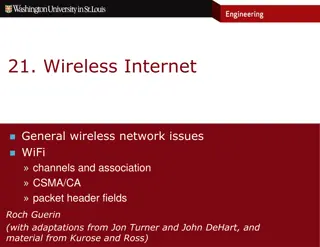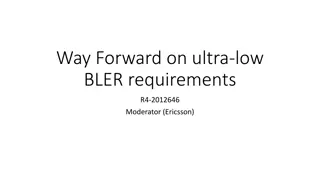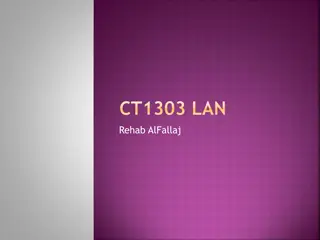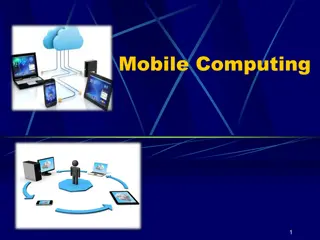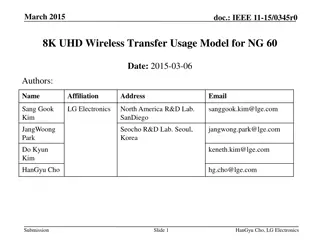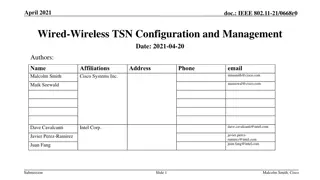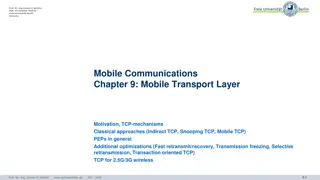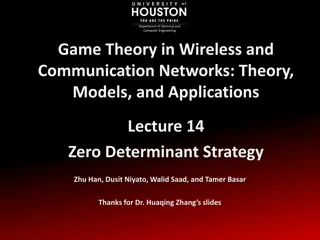Understanding Wireless and Mobile Communication Fundamentals
Explore the basics of wireless and mobile communication, covering topics such as transmitting voice and data through electromagnetic waves, the electromagnetic spectrum, wavelength of different technologies, frequency channels, and examples of channel allocation between stations. Learn about simplex communication and full-duplex communication methods for effective information transmission.
- Wireless Communication
- Mobile Communication
- Electromagnetic Waves
- Frequency Channels
- Communication Technologies
Download Presentation

Please find below an Image/Link to download the presentation.
The content on the website is provided AS IS for your information and personal use only. It may not be sold, licensed, or shared on other websites without obtaining consent from the author. Download presentation by click this link. If you encounter any issues during the download, it is possible that the publisher has removed the file from their server.
E N D
Presentation Transcript
Introduction: What is Wireless and Mobile Communication? Dr. Yeffry Handoko Putra, M.T Universitas Komputer Indonesia
Transmitting voice and data using electromagnetic waves in open space Electromagnetic waves Travel at speed of light (c = 3x108 m/s) Has a frequency (f) and wavelength ( ) c = f x Higher frequency means higher energy photons The higher the energy photon the more penetrating is the radiation
Electromagnetic Spectrum 104 102 100 10-2 10-4 10-6 10-8 10-10 10-12 10-14 10-16 Radio Spectrum Micro wave Cosmic Rays IR UV X-Rays 104 106 108 1010 1012 1014 1016 1018 1020 1022 1024 1MHz ==100m 100MHz ==1m 10GHz ==1cm Visible light < 30 KHz VLF 30-300KHz LF 300KHz 3MHz MF 3 MHz 30MHz HF 30MHz 300MHz VHF 300 MHz 3GHz UHF 3-30GHz SHF > 30 GHz EHF 3
Wavelength of Some Technologies GSM Phones: (Global System for Mobile) frequency ~= 900 MHz wavelength ~= 33cm PCS Phones (Personal communication System) frequency ~= 1.8 GHz wavelength ~= 17.5 cm Bluetooth: frequency ~= 2.4GHz wavelength ~= 12.5cm
Frequency Carries/Channels The information from sender to receiver is carrier over a well defined frequency band. This is called a channel Each channel has a fixed frequency bandwidth (in KHz) and Capacity (bit-rate) Different frequency bands (channels) can be used to transmit information in parallel and independently.
Example Assume a spectrum of 90KHz is allocated over a base frequency b for communication between stations A and B Assume each channel occupies 30KHz. There are 3 channels Each channel is simplex (Transmission occurs in one way) For full duplex communication: Use two different channels (front and reverse channels) Use time division in a channel Channel 1 (b - b+30) Station A Channel 2 (b+30 - b+60) Station B Channel 3 (b+60 - b+90)
Simplex Communication Normally, on a channel, a station can transmit only in one way. This is called simplex transmision To enable two-way communication (called full- duplex communication) We can use Frequency Division Multiplexing We can use Time Division Multiplexing
Duplex Communication - FDD FDD: Frequency Division Duplex Mobile Terminal M Forward Channel Reverse Channel Base Station B Forward Channel and Reverse Channel use different frequency bands
Duplex Communication - TDD TDD: Time Division Duplex Mobile Terminal M Base Station B M B M B M B A singe frequency channel is used. The channel is divided into time slots. Mobile station and base station transmits on the time slots alternately.
Example - Frequency Spectrum Allocation in U.S. Cellular Radio Service Reverse Channel Forward Channel 991 992 1023 1 2 799 991 992 1023 1 2 799 824-849 MHz 869-894 MHz Channel Number Center Frequency (MHz) Reverse Channel 1 <=N <= 799 991 <= N <= 1023 0.030N + 825.0 0.030(N-1023) + 825.0 Forward Channel 1 <=N <= 799 991 <= N <= 1023 0.030N + 870.0 0.030(N-1023) + 870.0 (Channels 800-990 are unused) Channels (Forward and Reverse) are separated by is 45 MHz
What is Mobility Initially Internet and Telephone Networks is designed assuming the user terminals are static No change of location during a call/connection A user terminals accesses the network always from a fixed location Mobility and portability Portability means changing point of attachment to the network offline Mobility means changing point of attachment to the network online
Degrees of Mobility Walking Users Low speed Small roaming area Usually uses high-bandwith/low-latency access Vehicles High speeds Large roaming area Usually uses low-bandwidth/high-latency access Uses sophisticated terminal equipment (cell phones)
The Need for Wireless/Mobile Networking Demand for Ubiquitous Computing Anywhere, anytime computing and communication You don t have to go to the lab to check your email Pushing the computers more into background Focus on the task and life, not on the computer Use computers seamlessly to help you and to make your life more easier. Computers should be location aware Adapt to the current location, discover services
Some Example Applications of Ubiquitous Computing You walk into your office and your computer automatically authenticates you through your active badge and logs you into the Unix system You go to a foreign building and your (Personal Digital Assistant) PDA automatically discovers the closest public printer where you can print your schedule and give to your friend
What is PCS Personal Communication Services A wide variety of network services that includes wireless access and personal mobility services Provided through a small terminal Enables communication at any time, at any place, and in any form. The market for such services is tremendously big Think of cell-phone market
Several PCS systems High-tier Systems GSM: Global System for Mobile Communications The mobile telephony system that we are using IS-136 (Interim State) USA digital cellular mobile telephony system TDMA based multiple access Personal Digital Cellular IS-95 cdmaOne System CDMA based multiple access
Several PCS systems Low-tier systems Residential, business and public cordless access applications and systems Cordless Telephone 2 (CT2) Digital Enhanced Cordless Telephone (DECT) Personal Access Communication Systems (PACS) Personal Handy Telephone System (PHS)
Several PCS systems Wideband wireless systems For Internet access and multimedia transfer Cdma2000 W-CDMA, proposed by Europe SCDMA, proposed by Chine/Europe
Several PCS systems Other PCS Systems Special data systems CDPD: Cellular Digital Packet Data RAM Mobile Data Advanced Radio Data Information System (ARDIS) Paging Systems Mobile Satellite Systems LEO, MEO, HEO satellites for data/voice ISM band systems: Bluetooth, 802.11, etc.
PCS Problems How to integrate mobile and wireless users to the Public Switched Telephone Network (PSTN) (Voice Network) Cellular mobile telephony system How to integrate mobile and wireless users to the Internet (Data Network) Mobile IP, DHCP, Cellular IP How to integrate all of them together and also add multimedia services (3G Systems)
Looking to PCS from different Angles PSTN Internet (Telephone Network) Wireless Access Mobile Users -Laptop users -Pocket PC users -Mobile IP, Dynamic Host Configuration Protocol DHCP enabled computers Mobile Users -Cell phone users -Cordless phone users Telecom People View Data Networking People View
Very Basic Cellular/PCS Architecture Mobility Database Public Switched Telephone Network Base Station Controller Mobile Switching Center (MSC) Radio Network Base Station (BS) Mobile Station
Wireless System Definitions Mobile Station A station in the cellular radio service intended for use while in motion at unspecified locations. They can be either hand-held personal units (portables) or installed on vehicles (mobiles) Base station A fixed station in a mobile radio system used for radio communication with the mobile stations. Base stations are located at the center or edge of a coverage region. They consists of radio channels and transmitter and receiver antennas mounted on top of a tower.
Wireless System Definitions Mobile Switching Center Switching center which coordinates the routing of calls in a large service area. In a cellular radio system, the MSC connections the cellular base stations and the mobiles to the PSTN (telephone network). It is also called Mobile Telephone Switching Office (MTSO) Subscriber A user who pays subscription charges for using a mobile communication system Transceiver A device capable of simultaneously transmitting and receiving radio signals
Wireless System Definitions Simplex Systems Communication systems which provide only one-way communication Half Duplex Systems Communication Systems which allow two-way communication by using the same radio channel for both transmission and reception. At any given time, the user can either transmit or receive information. Full Duplex Systems Communication systems which allow simultaneous two-way communication. Transmission and reception is typically on two different channels (FDD).
Wireless System Definitions Handoff The process of transferring a mobile station from one channel or base station to an other. Roamer A mobile station which operates in a service area (market) other than that from which service has been subscribed. Page A brief message which is broadcast over the entire service area, usually in simulcast fashion by many base stations at the same time.
PCS Systems Classification Cordless Telephones Cellular Telephony (High-tier) Wide Area Wireless Data Systems (High-tier) High Speed Local and Personal Area Networks Paging Messaging Systems Satellite Based Mobile Systems 3G Systems
Major Mobile Radio Standards USA Standard Type Year Intro Multiple Access Frequency Band (MHz) Modulation Channel BW (KHz) Cellular 1983 FDMA 824-894 FM 30 AMPS Cellular 1991 TDMA 824-894 DQPSK 30 USDC Cellular 1993 FH/Packet 824-894 GMSK 30 CDPD(Cellular Digital Packet Data) IS-95 (Interim standard) FLEX( free Open source for web appl) DCS-1900 (GSM) PACS (PICTURE Cellular/PCS 1993 CDMA 824-894 1800-2000 QPSK/BPSK 1250 Paging 1993 Simplex Several 4-FSK 15 PCS 1994 TDMA 1850-1990 GMSK 200 Cordless/PCS 1994 TDMA/FDMA 1850-1990 DQPSK 300
Major Mobile Radio Standards - Europe Standard Type Year Intro Multiple Access Frequency Band (MHz) Modulation Channel BW (KHz) Cellula r 1985 FDMA 900 FM 25 ETACS(Extended total access commn sys Cellula r 1986 FDMA 890-960 FM 12.5 NMT-900 (Nordic mobile tech Cellula r/PCS 1990 TDMA 890-960 GMSK 200KHz GSM Cellula r 1985 FDMA 450-465 FM 20-10 C-450 Paging 1993 FDMA4 Several 4-FSK 25 ERMES (European radio messaging sys Cordle ss 1989 FDMA 864-868 GFSK 100 CT2 (cordless telephony 2 Cordle ss 1993 TDMA 1880-1900 GFSK 1728 DECT(digital enhancedCommun Sys) Cordle ss/PC S 1993 TDMA 1710-1880 GMSK 200 DCS-1800 (digital cellular sys)
Cordless Telephones Characterized by Low mobility (in terms of range and speed) Low power consumption Two-way tetherless (wireless) voice communication High circuit quality Low cost equipment, small form factor and long talk-time No handoffs between base units Appeared as analog devices Digital devices appeared later with CT2, DECT standards in Europe and ISM band technologies in USA
Cordless Telephones Usage At homes At public places where cordless phone base units are available Design Choices Few users per MHz Few users per base unit Many base units are connected to only one handset Large number of base units per usage area Short transmission range
Cordless Phone Some more features 32 Kb/s adaptive differential pulse code modulation (ADPCM) digital speech encoding Tx power <= 10 mW Low-complexity radio signal processing No forward error correction (FEC) or whatsoever. Low transmission delay < 50ms Simple Frequency Shift Modulation (FSK) Time Division Duplex (TDD)
Cellular Telephony Characterized by High mobility provision Wide-range Two-way tetherless voice communication Handoff and roaming support Integrated with sophisticated public switched telephone network (PSTN) High transmit power requires at the handsets (~2W)
Cellular Telephony - Architecture Radio tower PSTN Telephone Network Mobile Switching Center
Cellular Telephony Systems Mobile users and handsets Very complex circuitry and design Base stations Provides gateway functionality between wireless and wireline links Mobile switching centers Connect cellular system to the terrestrial telephone network
Cellular Networks First Generation Analog Systems Analog Modulation, mostly FM AMPS Voice Traffic FDMA/FDD multiple access Second Generation (2G) Digital Systems Digital Modulation Voice Traffic TDMA/FDD and CDMA/FDD multiple access 2.5G Digital Systems Voice + Low-datarate Data Third Generation Digital Voice + High-datarate Data Multimedia Transmission also
2G Technologies cdmaOne (IS-95) GSM, DCS-1900 IS-54/IS-136 PDC Uplink Frequencies (MHz) 824-849 (Cellular) 1850-1910 (US PCS) 890-915 MHz (Eurpe) 1850-1910 (US PCS) 800 MHz, 1500 Mhz (Japan) 1850-1910 (US PCS) Downlink Frequencies 869-894 MHz (US Cellular) 1930-1990 MHz (US PCS) 935-960 (Europa) 1930-1990 (US PCS) 869-894 MHz (Cellular) 1930-1990 (US PCS) 800 MHz, 1500 MHz (Japan) Deplexing FDD FDD FDD Multiple Access CDMA TDMA TDMA DQPSK Modulation BPSK with Quadrature Spreading GMSK with BT=0.3 Carrier Seperation 1.25 MHz 200 KHz 30 KHz (IS-136) (25 KHz PDC) Channel Data Rate 1.2288 Mchips/sec 270.833 Kbps 48.6 Kbps (IS-136) 42 Kbps (PDC) Voice Channels per carrier 64 8 3 Speech Coding CELP at 13Kbps EVRC at 8Kbps RPE-LTP at 13 Kbps VSELP at 7.95 Kbps
2G and Data 2G is developed for voice communications You can send data over 2G channels by using modem Provides a data rates in the order of ~9.6 Kbps Increased data rates are requires for internet application This requires evolution towards new systems: 2.5 G
2.5 Technologies Evolution of TDMA Systems HSCSD (High speed Circuit Switched Data) for 2.5G GSM Up to 57.6 Kbps data-rate GPRS (General Packet Radio Services) for GSM and IS-136 Up to 171.2 Kbps data-rate EDGE (Enhanced Data For Global Evolution) for 2.5G GSM and IS-136 Up to 384 Kbps data-rate Evolution of CDMA Systems IS-95B Up to 64 Kbps
3G Systems Goals Voice and Data Transmission Simultanous voice and data access Multi-megabit Internet access Interactive web sessions Voice-activated calls Multimedia Content Live music
3G Systems Evolution of Systems CDMA sysystem evaolved to CDMA2000 CDMA2000-1xRTT: Upto 307 Kbps CDMA2000-1xEV: CDMA2000-1xEVDO: upto 2.4 Mbps CDMA2000-1xEVDV: 144 Kbps datarate GSM, IS-136 and PDC evolved to W-CDMA (Wideband CDMA) (also called UMTS) Up to 2.048 Mbps data-rates Future systems 8Mbps Expected to be fully deployed by 2010-2015 New spectrum is allocated for these technologies
Upgrade Paths for 2G Technologies 2G IS-136 PDC IS-95 GSM 2.5G GPRS HSCSD IS-95B EDGE 3G cdma200-1xRTT W-CDMA EDGE cdma2000-1xEV,DV,DO TD-SCDMA cdma200-3xRTT





